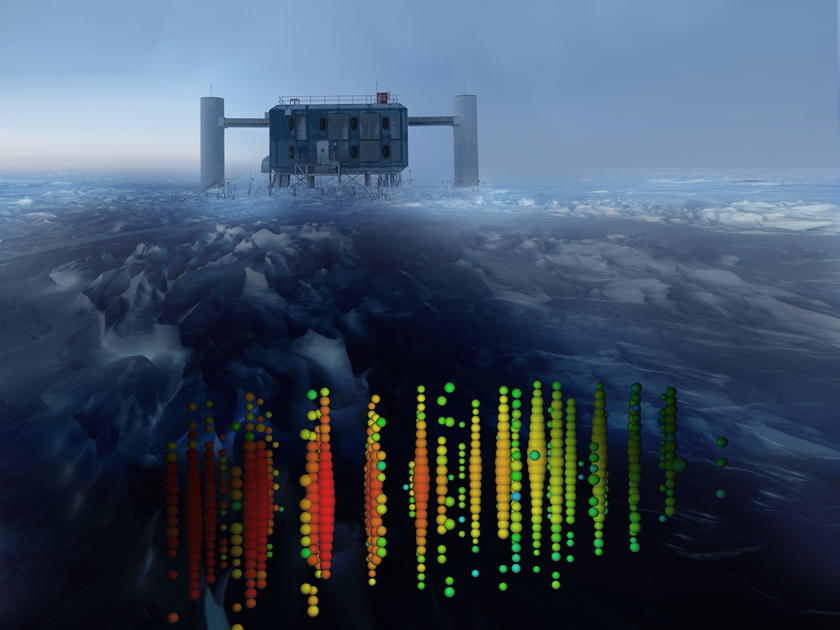
The ICL and a high-energy muon neutrino (day). This image shows one of the highest-energy neutrino events of this study superimposed on a view of the IceCube Lab (ICL) at the South Pole. Credit: IceCube Collaboration.
The IceCube Collaboration has announced a new observation of high-energy neutrinos that originated beyond our solar system. This study, which looked for neutrinos coming from the Northern Hemisphere, confirms their cosmic origin as well as the presence of extragalactic neutrinos and the intensity of the neutrino rate. The first evidence for astrophysical neutrinos was announced by the collaboration in November 2013. The new results, published in Physical Review Letters, are the first independent confirmation of this discovery.
Chris Weaver, the primary author of the paper, recently moved to Edmonton to join the University of Alberta as a postdoctoral fellow. Weaver is a member of the international research team that operates the IceCube Neutrino Observatory in Antarctica. The University of Alberta leaders of the experiment are Associate Professor Darren Grant and Assistant Professor Claudio Kopper.
Weaver's interest in neutrinos extends back to his undergraduate days. "When I was an undergraduate student I worked for a gamma-ray astronomy group (a part of VERITAS), and neutrino astronomy has the potential to be an important complement. Working on IceCube is particularly interesting because of further connections to more traditional particle physics (in areas like neutrino oscillations and air shower physics), and because it's still a relatively new field."
He began working on IceCube as a graduate student in 2008. "Since then, I've worked on a number of tasks ranging from low level detector calibration to writing new simulation software to more accurately represent the behaviour of the detector hardware, as well as preparing the data sample and analysis which formed my thesis work, which is presented in the paper."
Weaver discussed the significance of the paper. "This paper shows the first significant evidence (although it does not by itself rise to a discovery level) of astrophysical neutrinos which are both muon flavored and originating in the Northern sky.
"In previous papers, IceCube has shown evidence for astrophysical neutrinos from the Southern sky, but there has been some skepticism from the community that our findings extended to the northern sky, particularly when a discovery had long been expected to be first visible in muon neutrinos, whose importance was not actually very great in the papers so far," said Weaver.
Neutrinos are subatomic particles that travel throughout the universe almost undisturbed by matter, pointing directly to the sources where they were created. And for the highest energy neutrinos, those sources are expected to be the most extreme environments in the universe: powerful cosmic generators, such as black holes or massive exploding stars, that are able to accelerate cosmic rays to energies over a million times the energies achieved by record-breaking human-made accelerators, such as the LHC at CERN.
Neutrinos are never directly observed, but IceCube is able to see the by-products of a neutrino interaction with the Antarctic ice. This cubic-kilometer detector records a hundred thousand neutrinos every year, most of them produced by the interaction of cosmic rays with the Earth's atmosphere. Billions of atmospheric muons created in the same interactions also leave traces in IceCube. And from all of these, researchers are looking for only a few dozen astrophysical neutrinos, which will expand our current understanding of the universe.
"Cosmic neutrinos are the key to yet unexplored parts of our universe and might be able to finally reveal the origins of the highest energy cosmic rays, including the rare 'Oh-My-God' particles," says collaboration spokesperson Olga Botner, of Uppsala University. "The discovery of astrophysical neutrinos hints at the dawn of a new era in astronomy."
Weaver added that there is much more work to be done by neutrino researchers. "Now that we have established the existence of astrophysical neutrinos, there's still a great deal more we would like to know about them," he said.
"Ideally, we would like to determine the objects which produce them, but this may prove extremely challenging with our existing equipment, so my main interest at the moment is to try to refine other aspects of our knowledge, by answering questions like whether the energy distribution of neutrinos or the composition, in terms of types of neutrinos, coming from all regions of the sky is the same."